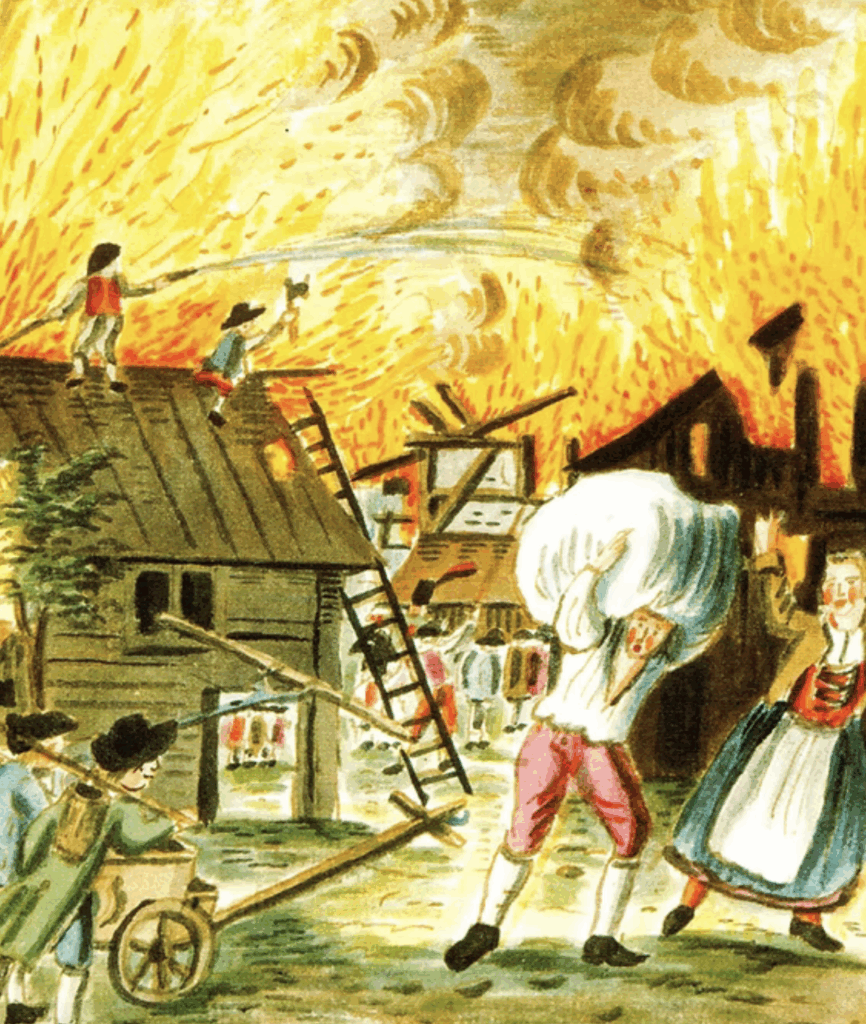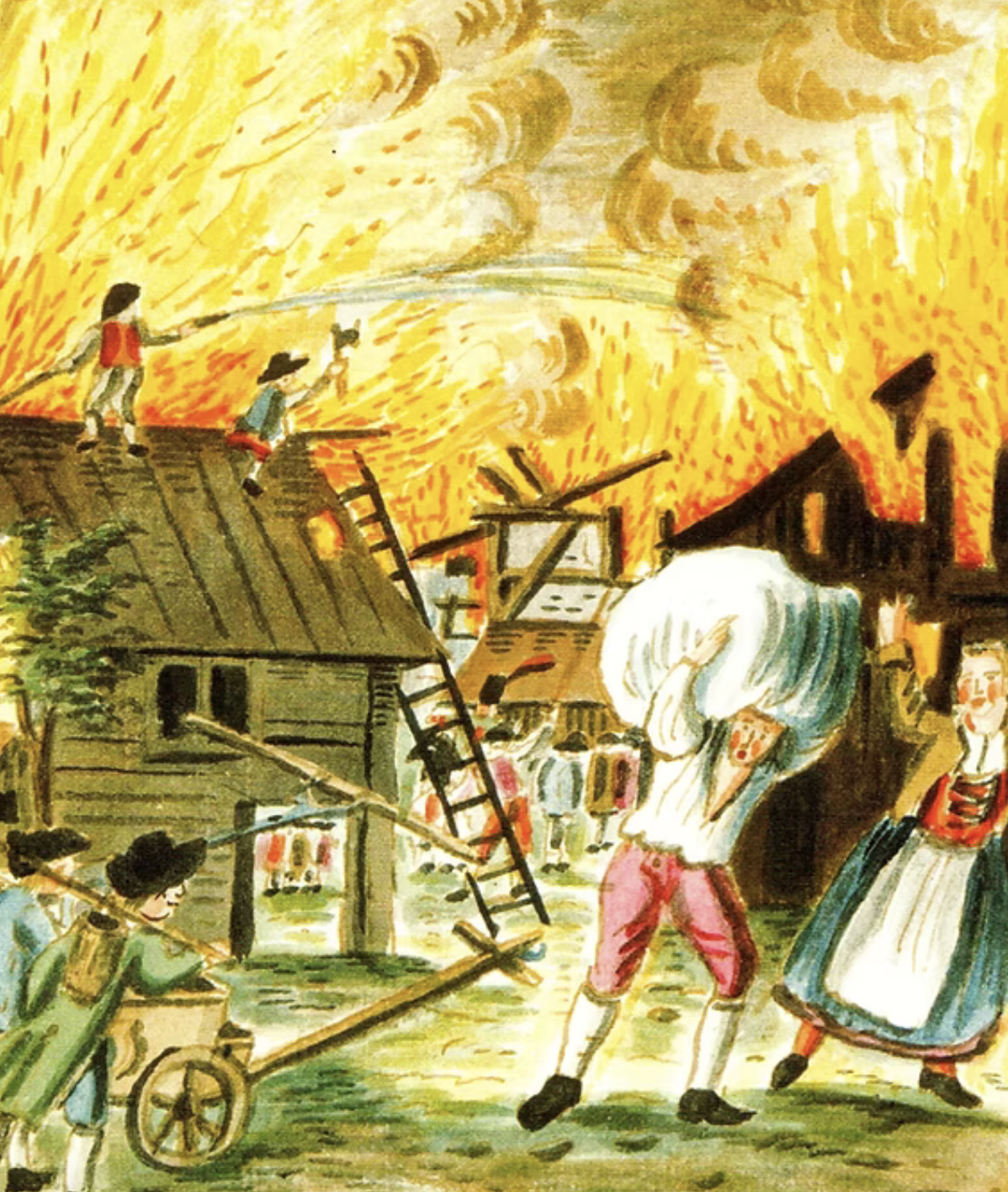Lessons from fire incidents and response in the 19th century
The Incident: Human Error, Late Detection, and Insufficient Equipment
On 4 September 1803, Johannes Temperli walked home to Gutenswil with his family after Sunday church in the neighboring village of Volketswil. The air was still warm from the late summer sun, and the smell of fresh hay from a successful harvest lingered in the village. Johannes, already thinking about lunch, was pulled out of his daydreams by frantic shouting.
“Fire!”
His neighbor sprinted past with a bucket of water. Only then did Johannes understand — smoke was rising from behind his own house. “The little one from Keller’s has been playing with fire!” the neighbor yelled. “In your shed!”
Johannes ran. Flames were already climbing up the wooden structure, no higher than a man’s waist yet — but growing. Neighbors rushed to form a bucket chain. Water sloshed from one pair of hands to another. It barely slowed the blaze.
“Fetch help from the next villages!” Johannes shouted to his wife as he joined the line. “We must contain the fire before it spreads further!”
The Response: Fire Engines, Horse Carts — and an Empty Pond
Help did arrive. Soon, fire engines and volunteers from the surrounding villages rolled in — nearly forty in total. For a moment, there was hope.
But the village fire pond was emptied within minutes.
The men tried to haul water from another pond over the hill with horse carts, but the road was too hot. The plan failed. Despite their courage, the firefighters were left nearly defenseless against the inferno.

Quelle: Chronikstube des Vereins Ortsgeschichte Volketwil, VOV)
The recovery: High Costs and Destroyed Infrastructure
The people of Gutenswil fought until evening, but the fire could not be contained. Only five houses in the lower village remained standing. Fourteen burned to the ground, leaving thirty-nine households — 205 people — without a home. Fortunately, no lives were lost. Under the coordination of Pastor Weiss and the canton, donations and reconstruction funds were raised. The village rebuilt — but at enormous cost.
How Could This Incidents Have Been Prevented?
Gutenswil was not ready for a disaster of this scale. The risk was obvious — dry wooden structures, barns full of hay, limited water reserves — yet no one had officially documented or assessed these dangers. There were no structural protections such as firebreaks or rules restricting open flames. No early warning system existed — detection relied on luck alone. When the fire struck, response efforts were courageous but chaotic, lacking predefined roles and coordinated plans. While recovery was impressively community-driven, it was slow and ineffective. Most governance measures — such as new regulations and levies — were only introduced after the disaster.
The Turning Point: Building a Cantonal Fire Protection Ecosystem
The people of the 19th century understood that relying on courage alone was no longer enough. Switzerland already had firefighters and equipment — but they operated independently, without coordination. So several cantons introduced a groundbreaking initiative: public building insurance institutions (Gebäudeversicherungen). These entities funded training and equipment, and coordinate the firefighter’s deployment. In exchange they hold a monopoly on building insurance which every homeowner is obliged to purchase. To this day, everyone benefits from this systematic protection.
The result? Fewer fires. Smaller damages. Faster recovery.
Switzerland had discovered a winning formula: pooling expertise, funding, and governance into a unified protection ecosystem.
Today’s Fire Is Digital — and We Need the Same Approach
Now, Switzerland faces a new kind of threat — not made of flames, but of data breaches, ransomware, and operational disruptions. Cyber incidents are today what village fires were in 1803: predictable, preventable — yet too often ignored until it’s too late.
Just like Gutenswil back then, our response to cyber risks is fragmented. We have talent. We have tools. But we lack a shared structure that connects prevention, detection, response, recovery, and regulation into a single, resilient system.
It is time for Switzerland to build another protection ecosystem — but this time for cybersecurity.
| NIST Function | Historical Fire Example (Gutenswil 1803) | What Was Missing / Weakness | Cybersecurity Parallel |
| Identify | Villagers knew barns full of hay and dry wooden houses were dangerous | No formal risk assessment, no registry of critical assets | Asset inventory, risk assessments, business impact analysis |
| Protect | Bucket chains, occasional bans on flames (informal) | No firebreaks, no building separation, insufficent water reservoirs, no safety policies | Network segmentation, access controls, secure configuration, backups |
| Detect | Fire was spotted by chance by a neighbor | No alarm bell, no watchtower, no early-warning mechanisms | Monitoring, intrusion detection systems (IDS), SIEM alerts |
| Respond | Neighbors formed bucket chains and fetched help from nearby villages | Response was brave but uncoordinated; no defined roles, no drills, no equipment readiness | Incident response plans, playbooks, SOC coordination, forensic analysis |
| Recover | Villagers relocated to nearby towns; Pastor Weiss and the canton organized donations and rebuilding funds | Recovery was slow, expensive, only partly covered by relief funds | Business continuity planning, disaster recovery funding, cyber insurance |
| Govern | After the fire, cantons introduced building insurance institutions to standardize protection | Governance came only after the disaster; no ownership before | Security governance models, regulation/standards, roles, responsibilities, processes, oversight |
CYRENZH and Insurances: The Added Value of Collaboration
The historical success of Switzerland’s building insurance institutions shows how systematic protection emerges when expertise, financing, and public service align. Today, cybersecurity requires a similar coalition. CYRENZH — as an academic hub for research, education, and social engagement — offers insurers a unique opportunity to become not just payers of damages, but partners in prevention.
1. Research – Better Risk Models Through Shared Knowledge
For insurers, access to cutting-edge academic research is more than a prestige factor — it is a data advantage. Cyber risks evolve rapidly, and reliable models depend not only on historical claims data but on emerging attack patterns, human behavior insights, and technological trends. Through collaboration with CYRENZH insurers gain:
- Better risk models through access to current datasets and behavioral studies that are otherwise difficult to obtain.
- Innovation momentum — enabling the co-development of new insurance products such as cyber prevention bundles for SMEs or awareness modules for policyholders.
- A reputational edge, positioning themselves as proactive safety partners rather than passive indemnifiers.
2. Education – Prevention as the Most Sustainable Cost Cutter
Every well-trained customer is a prevented claim. By integrating insurers into CYRENZH ’s educational initiatives — from university courses to public workshops — both sides win:
- Fewer incidents, because informed clients recognize and avoid digital risks.
- Lower payouts, as successful attacks, fraud attempts, and liability claims decrease.
Just as past fire insurance institutions funded public fire drills and safety campaigns, modern insurers can co-invest in cybersecurity awareness — and profit directly from lower loss ratios.
3. Community Engagement – Strengthening the SME Backbone
Most Swiss insurers have one core customer segment in common: small and medium-sized enterprises (SME). CYRENZH is developing several initiatives to engage people in actively contributing to the canton’s cyber resilience. The Cybersecurity Clinic has already improved the cybersecurity at several SMEs in the Canton of Zurich and beyond. Other efforts are ongoing to explore how we can train citizens to amplify cybersecurity efforts at a national level, see e.g., our workshop on unleashing the potential of retirees (in German). Supporting such initiatives yields multiple benefits fr insurers:
- Higher resilience in the SME sector reduces the overall claims burden.
- Early access and training of the next generation, just as fire insurance companies once relied on volunteer firefighters who later became full-time specialists.
- A stronger ecosystem position, as insurers become seen as builders, not just bill-payers.
Call to Action
Just as fire insurance once transformed chaos into coordinated resilience, cybersecurity now demands a similar alliance. CYRENZH offers the platform — insurers can provide the force. Together, we can turn risk into readiness.

